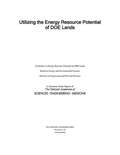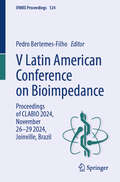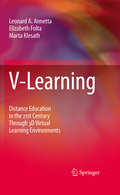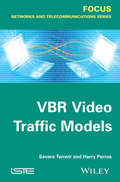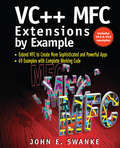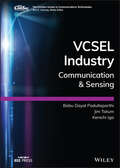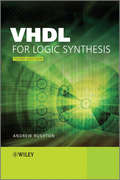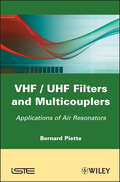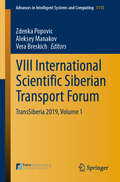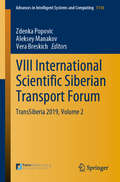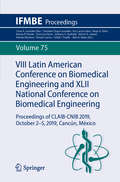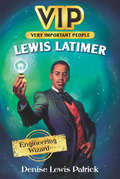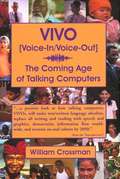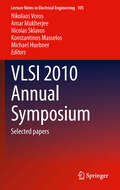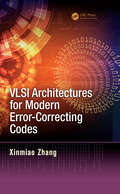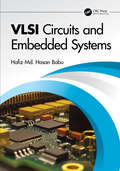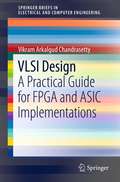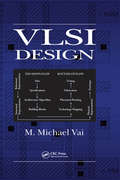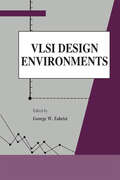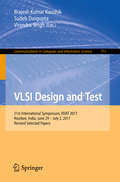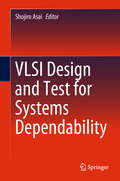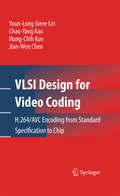- Table View
- List View
Utilizing the Energy Resource Potential of DOE Lands
by Engineering Medicine National Academies of SciencesThe potential for energy resource development on Department of Energy (DOE)-managed lands remains a topic of interest within DOE, Congress, and with private developers interested in siting projects on DOE lands. Several previous studies have estimated the energy resource development potential using various approaches and methodologies. The National Renewable Energy Laboratory (NREL) was tasked by the DOE Office of Legacy Management in 2013 with conducting a study to further refine and build upon previous analyses and to assess energy resource development potential on these lands. Utilizing the Energy Resource Potential of DOE Lands reviews and comments on the NREL study.
V Latin American Conference on Bioimpedance: Proceedings of CLABIO 2024, November 26-29, 2024, Joinville, Brazil (IFMBE Proceedings #124)
by Pedro Bertemes-FilhoThis book offers a timely snapshot on the developments in the field of bioimpedance, covering diverse applications such as in medicine, food industry and other fields. Gathering the proceedings of the X Latin American Conference on Bioimpedance, CLABIO 2024, held online on November 26-29 2024, from Joinville, Brazil, this book highlights key findings in the field, as well as the results of interdisciplinary discussion between different researchers and stakeholders from the fields of Biomedical Engineering, Medical Physics, Medicine, Environmental Science, Biology, and Chemistry. It offers extensive information on bioimpedance and related technologies, and a lively discussion on future challenges and technologies.
V-Learning
by Leonard A. Annetta Elizabeth Folta Marta KlesathEqually grounded in the research and the practical applications developed by the authors over a number of years, this book shows how virtual learning environments could represent the future of higher education. As academics begin to use environments such as Second Life to reach a broader student audience, this volume offers the distance-learning community (administrators, faculty, and students) a different, yet successful, approach to delivering content over the Internet through 3D virtual learning environments that have the potential to transform higher education. Covering a broad spectrum of frameworks, from commercial multiplayer video games to online learning, the book shows just how powerful these environments can be in the arena of education, and concludes that data-driven practice will ensure almost universal take-up, even among those currently unwilling to use V-learning. The authors provide numerous practical examples of distance learning in its current state of development, as well as making informed predictions about how future environments might evolve. This much-needed book is right at the cutting edge of its subject, and comes at a time when research in both educational gaming and distance learning are converging.
VBA für Office-Automatisierung und Digitalisierung
by Irene WeberVBA bietet das Potenzial, effektive Digitalisierungslösungen mit geringem Aufwand zu realisieren. “VBA für Office-Automatisierung und Digitalisierung" zeigt mit vielen Codebeispielen die Automatisierung von Excel, Word, Outlook, PowerPoint, SAP ERP und SOLIDWORKS und das Zusammenwirken dieser Systeme. Auch Webservices und Rest APIs werden mit VBA angesprochen und erschließen interessante Möglichkeiten bis hin zu KI. Das Buch erläutert wichtige Konzepte und gibt viele Tipps, um VBA-Anwendungen mit einfachen Mitteln unternehmenstauglich und administrierbar zu gestalten.
VBR Video Traffic Models (Focus Ser.)
by Harry G. Perros Savera TanwirThere has been a phenomenal growth in video applications over the past few years. An accurate traffic model of Variable Bit Rate (VBR) video is necessary for performance evaluation of a network design and for generating synthetic traffic that can be used for benchmarking a network. A large number of models for VBR video traffic have been proposed in the literature for different types of video in the past 20 years. Here, the authors have classified and surveyed these models and have also evaluated the models for H.264 AVC and MVC encoded video and discussed their findings.
VC++ MFC Extensions by Example
by John SwankeExtend and modify MFC code to meet your needs! Author John Swanke delivers studied examples to give you a jump-start on creating more sophisticated and powerful applications. Each example is fully annotated and ready to insert into the your application --
VCO-Based Quantizers Using Frequency-to-Digital and Time-to-Digital Converters
by Mohammed Ismail Waleed Khalil Samantha YoderThis book introduces the concept of voltage-controlled-oscillator (VCO)-based analog-to-digital converters (ADCs). Detailed explanation is given of this promising new class of high resolution and low power ADCs, which use time quantization as opposed to traditional analog-based (i.e. voltage) ADCs.
VCSEL Industry: Communication and Sensing (The ComSoc Guides to Communications Technologies)
by Kenichi Iga Babu Dayal Padullaparthi Jim TatumA hands-on reference to the technical, commercial, and industrial aspects of VCSEL technology In VCSEL Industry: Communication and Sensing, a team of distinguished researchers and manufacturing professionals deliver a thorough and practical reference guide to vertical-cavity surface-emitting lasers (VCSELs) for young entrepreneurs, investors, venture capitalists, and researchers. The authors offer comprehensive descriptions of the technology involved, as well as a robust exploration of the industry and commercial landscape in which VCSELs exist. In VCSEL Industry: Communication and Sensing, distinguished researchers and manufacturing professionals Dr. Padullaparthi Babu Dayal, Dr. Jim A Tatum and Prof. Kenichi Iga deliver a thorough and practical reference guide to vertical-cavity surface-emitting lasers (VCSELs) for young entrepreneurs, investors, venture capitalists, and researchers. The authors offer comprehensive descriptions of the technology involved, as well as a robust exploration of the industry and commercial landscape in which VCSELs exist. The book contains numerous illustrations and schematics of the anatomy of VCSEL product developments and an insightful discussion of the proliferation of VCSELs in photonics and optics. There is also a dedicated section on photoreceivers used for VCSEL-based data communications and sensing. VCSEL Industry: Communication and Sensing provides readers with an accessible, commercial perspective of an important technology while offering just enough technical detail to make sense of the subject. The book also includes: A thorough introduction to VCSELs, including discussions of semiconductor lasers, materials, wavelengths, and why VCSELs are attractive for photonics applications Comprehensive explorations of the VCSEL industry, including market demands, an industry landscape, descriptions of commercial products based on VCSELs, and business models Practical discussions of VCSELs for data communication, including high-speed VCSELs, gain and parasitic effects on bandwidth and speed, and form factors and standards In-depth examinations of VCSEL arrays for sensing, including high-power VCSELs in consumer electronics Perfect for early-career researchers, engineers, entrepreneurs, investors, and managers, VCSEL Industry: Communication and Sensing will also prove to be an invaluable addition to the libraries of executives from across the semiconductor industry.
VHDL for Logic Synthesis
by Andrew RushtonMaking VHDL a simple and easy-to-use hardware description languageMany engineers encountering VHDL (very high speed integrated circuits hardware description language) for the first time can feel overwhelmed by it. This book bridges the gap between the VHDL language and the hardware that results from logic synthesis with clear organisation, progressing from the basics of combinational logic, types, and operators; through special structures such as tristate buses, register banks and memories, to advanced themes such as developing your own packages, writing test benches and using the full range of synthesis types.This third edition has been substantially rewritten to include the new VHDL-2008 features that enable synthesis of fixed-point and floating-point hardware. Extensively updated throughout to reflect modern logic synthesis usage, it also contains a complete case study to demonstrate the updated features.Features to this edition include:a common VHDL subset which will work across a range of different synthesis systems, targeting a very wide range of technologiesa design style that results in long design lifetimes, maximum design reuse and easy technology retargeting a new chapter on a large scale design example based on a digital filter from design objective and design process, to testing strategy and test benchesa chapter on writing test benches, with everything needed to implement a test-based design strategyextensive coverage of data path design, including integer, fixed-point and floating-point arithmetic, logic circuits, shifters, tristate buses, RAMs, ROMs, state machines, and decodersFocused specifically on logic synthesis, this book is for professional hardware engineers using VHDL for logic synthesis, and digital systems designers new to VHDL but familiar with digital systems. It offers all the knowledge and tools needed to use VHDL for logic synthesis. Organised in themed chapters and with a comprehensive index, this complete reference will also benefit postgraduate students following courses on microelectronics or VLSI/ semiconductors and digital design.
VHF / UHF Filters and Multicouplers: Application of Air Resonators
by Bernard PietteThis book describes the various devices used in radio communication and broadcasting to achieve high selectivity filtering and coupling. After providing a background in the basics of microwave theory and more detailed material – including a special chapter on precision and errors in measurement – the reader will find detailed descriptions, manufacturing processes, and, for the most useful instances, a number of worked-through formulas, which will allow engineers and technicians to design circuits or components for filtering or coupling applications. Content is covered in this format across a broad range of fields including coaxial cavities, combline filters, band-pass and pass-reject duplexers, multicouplers, circulators, low-noise amplifiers, helix resonators, and much more.
VIII International Scientific Siberian Transport Forum: TransSiberia 2019, Volume 1 (Advances in Intelligent Systems and Computing #1115)
by Zdenka Popovic Aleksey Manakov Vera BreskichThis book presents the findings of scientific studies on the successful operation of complex transport infrastructures in regions with extreme climatic and geographical conditions.It features the proceedings of the VIII International Scientific Siberian Transport Forum, TransSiberia 2019, which was held in Novosibirsk, Russia, on May 22–27, 2019. The book discusses improving energy efficiency in the transportation sector and the use of artificial intelligence in transport, highlighting a range of topics, such as freight and logistics, freeway traffic modelling and control, intelligent transport systems and smart mobility, transport data and transport models, highway and railway construction and trucking on the Siberian ice roads. Consisting of 214 high-quality papers on a wide range of issues, these proceedings appeal to scientists, engineers, managers in the transport sector, and anyone involved in the construction and operation of transport infrastructure facilities.
VIII International Scientific Siberian Transport Forum: TransSiberia 2019, Volume 2 (Advances in Intelligent Systems and Computing #1116)
by Zdenka Popovic Aleksey Manakov Vera BreskichThis book presents the findings of scientific studies on the successful operation of complex transport infrastructures in regions with extreme climatic and geographical conditions.It features the proceedings of the VIII International Scientific Siberian Transport Forum, TransSiberia 2019, which was held in Novosibirsk, Russia, on May 22–27, 2019. The book discusses improving energy efficiency in the transportation sector and the use of artificial intelligence in transport, highlighting a range of topics, such as freight and logistics, freeway traffic modelling and control, intelligent transport systems and smart mobility, transport data and transport models, highway and railway construction and trucking on the Siberian ice roads. Consisting of 214 high-quality papers on a wide range of issues, these proceedings appeal to scientists, engineers, managers in the transport sector, and anyone involved in the construction and operation of transport infrastructure facilities.
VIII Latin American Conference on Biomedical Engineering and XLII National Conference on Biomedical Engineering: Proceedings of CLAIB-CNIB 2019, October 2-5, 2019, Cancún, México (IFMBE Proceedings #75)
by César A. González Díaz Christian Chapa González Eric Laciar Leber Hugo A. Vélez Norma P. Puente Dora-Luz Flores Adriano O. Andrade Héctor A. Galván Fabiola Martínez Renato García Citlalli J. Trujillo Aldo R. MejíaThis book gathers the joint proceedings of the VIII Latin American Conference on Biomedical Engineering (CLAIB 2019) and the XLII National Conference on Biomedical Engineering (CNIB 2019). It reports on the latest findings and technological outcomes in the biomedical engineering field. Topics include: biomedical signal and image processing; biosensors, bioinstrumentation and micro-nanotechnologies; biomaterials and tissue engineering. Advances in biomechanics, biorobotics, neurorehabilitation, medical physics and clinical engineering are also discussed. A special emphasis is given to practice-oriented research and to the implementation of new technologies in clinical settings. The book provides academics and professionals with extensive knowledge on and a timely snapshot of cutting-edge research and developments in the field of biomedical engineering.
VIP: Engineering Wizard (VIP #1)
by Denise Lewis PatrickGet ready to light up the world with Lewis Latimer in this exciting middle grade nonfiction biography. Perfect for fans of the Who Was and Little Leaders series, the books in the VIP series tell the true—and amazing—stories of some of history's greatest trailblazers. Meet the VERY IMPORTANT PEOPLE who changed the world! Lewis Latimer was one of the greatest inventors of his time. He was also an engineer who transformed the lightbulb at Thomas Edison’s company. And he was a gifted artist, too! Experience all the exciting moments in Lewis Latimer’s thrilling life in this exciting biography, packed with two-color illustrations and fun facts, like who invented the Super Soaker!Short and engaging chapters are interspersed with special lists and other information made to order to engage kids, whether they're already biography fans or "have to" write a report for school. Extras include a timeline, a bibliography, and a hall of fame of other successful African American inventors.The VIP series features inspiring adventures and fun facts about some of history's greatest trailblazers—smart, tough, persevering innovators who will inspire today's kids. Featuring underappreciated historical figures and groups, with a focus on leaders in science and technology, the nonfiction biographies in the VIP series are fun and engaging. Just looking at the cover will make kids want to learn more about these VIPs, and once they dive in they will zoom through stories that read like adventures.Each book in the VIP series allows your middle grader to experience all the exciting moments in some very important but lesser known lives. These biographies for kids age 9-12 include: VIP: Dr. Mae Jemison: Brave Rocketeer: Engineering Wizard; VIP: Mahalia Jackson: Freedom's Voice; and VIP: Lydia Darragh: Unexpected Spy.
VIVO [Voice-in/Voice-Out]: The Coming Age of Talking Computers
by William CrossmanA positive look at how talking computers, VIVOs, will make text/written language obsolete, replace all writing and reading with speech and graphics, democratize information flow worldwide, and recreate an oral culture by 2050.
VLSI 2010 Annual Symposium
by Nicolas Sklavos Amar Mukherjee Konstantinos Masselos Michael Huebner Nikolaos VorosVLSI 2010 Annual Symposium will present extended versions of the best papers presented in ISVLSI 2010 conference. The areas covered by the papers will include among others: Emerging Trends in VLSI, Nanoelectronics, Molecular, Biological and Quantum Computing. MEMS, VLSI Circuits and Systems, Field-programmable and Reconfigurable Systems, System Level Design, System-on-a-Chip Design, Application-Specific Low Power, VLSI System Design, System Issues in Complexity, Low Power, Heat Dissipation, Power Awareness in VLSI Design, Test and Verification, Mixed-Signal Design and Analysis, Electrical/Packaging Co-Design, Physical Design, Intellectual property creating and sharing.
VLSI Analog Filters
by P.V. Ananda MohanGreat strides have been made in the development of analog filters over the past few decades. The first book to treat these recent advances in depth, "VLSI Analog Filters" provides a comprehensive guide for researchers and upper-level graduate students, which fully prepares readers for professional work. In particular, the work covers active R filters, OTA-C filters, and switched-capacitor filters, including topics such as differential output opamps, sensitivity analysis for passive components, multiple-feedback techniques, double-sampling, and N-path filters. Throughout the book, exercises are included to reinforce understanding of concepts, and simulations are used to enhance connections to practical applications. This advanced textbook is suitable for engineering graduate students studying analog filter design, offering a full course that can feed seamlessly to employment industry. At the same time, it serves as an extremely valuable reference for researchers and engineers looking to gain a deeper understanding of the field.
VLSI Architectures for Modern Error-Correcting Codes
by Xinmiao ZhangError-correcting codes are ubiquitous. They are adopted in almost every modern digital communication and storage system, such as wireless communications, optical communications, Flash memories, computer hard drives, sensor networks, and deep-space probing. New-generation and emerging applications demand codes with better error-correcting capability. On the other hand, the design and implementation of those high-gain error-correcting codes pose many challenges. They usually involve complex mathematical computations, and mapping them directly to hardware often leads to very high complexity. VLSI Architectures for Modern Error-Correcting Codes serves as a bridge connecting advancements in coding theory to practical hardware implementations. Instead of focusing on circuit-level design techniques, the book highlights integrated algorithmic and architectural transformations that lead to great improvements on throughput, silicon area requirement, and/or power consumption in the hardware implementation. The goal of this book is to provide a comprehensive and systematic review of available techniques and architectures, so that they can be easily followed by system and hardware designers to develop en/decoder implementations that meet error-correcting performance and cost requirements. This book can be also used as a reference for graduate-level courses on VLSI design and error-correcting coding. Particular emphases are placed on hard- and soft-decision Reed-Solomon (RS) and Bose-Chaudhuri-Hocquenghem (BCH) codes, and binary and non-binary low-density parity-check (LDPC) codes. These codes are among the best candidates for modern and emerging applications due to their good error-correcting performance and lower implementation complexity compared to other codes. To help explain the computations and en/decoder architectures, many examples and case studies are included. More importantly, discussions are provided on the advantages and drawbacks of different implementation approaches and architectures.
VLSI Circuits and Embedded Systems
by Hafiz Md. BabuVery Large-Scale Integration (VLSI) creates an integrated circuit (IC) by combining thousands of transistors into a single chip. While designing a circuit, reduction of power consumption is a great challenge. VLSI designs reduce the size of circuits which eventually reduces the power consumption of the devices. However, it increases the complexity of the digital system. Therefore, computer-aided design tools are introduced into hardware design processes. Unlike the general-purpose computer, an embedded system is engineered to manage a wide range of processing tasks. Single or multiple processing cores manage embedded systems in the form of microcontrollers, digital signal processors, field-programmable gate arrays, and application-specific integrated circuits. Security threats have become a significant issue since most embedded systems lack security even more than personal computers. Many embedded systems hacking tools are readily available on the internet. Hacking in the PDAs and modems is a pervasive example of embedded systems hacking. This book explores the designs of VLSI circuits and embedded systems. These two vast topics are divided into four parts. In the book's first part, the Decision Diagrams (DD) have been covered. DDs have extensively used Computer-Aided Design (CAD) software to synthesize circuits and formal verification. The book's second part mainly covers the design architectures of Multiple-Valued Logic (MVL) Circuits. MVL circuits offer several potential opportunities to improve present VLSI circuit designs. The book's third part deals with Programmable Logic Devices (PLD). PLDs can be programmed to incorporate a complex logic function within a single IC for VLSI circuits and Embedded Systems. The fourth part of the book concentrates on the design architectures of Complex Digital Circuits of Embedded Systems. As a whole, from this book, core researchers, academicians, and students will get the complete picture of VLSI Circuits and Embedded Systems and their applications.
VLSI Design
by Vikram Arkalgud ChandrasettyThis book provides insight into the practical design of VLSI circuits. It is aimed at novice VLSI designers and other enthusiasts who would like to understand VLSI design flows. Coverage includes key concepts in CMOS digital design, design of DSP and communication blocks on FPGAs, ASIC front end and physical design, and analog and mixed signal design. The approach is designed to focus on practical implementation of key elements of the VLSI design process, in order to make the topic accessible to novices. The design concepts are demonstrated using software from Mathworks, Xilinx, Mentor Graphics, Synopsys and Cadence.
VLSI Design (VLSI Circuits #1)
by M. Michael VaiVery Large Scale Integration (VLSI) has become a necessity rather than a specialization for electrical and computer engineers. This unique text provides Engineering and Computer Science students with a comprehensive study of the subject, covering VLSI from basic design techniques to working principles of physical design automation tools to leading edge application-specific array processors.Beginning with CMOS design, the author describes VLSI design from the viewpoint of a digital circuit engineer. He develops physical pictures for CMOS circuits and demonstrates the top-down design methodology using two design projects - a microprocessor and a field programmable gate array. The author then discusses VLSI testing and dedicates an entire chapter to the working principles, strengths, and weaknesses of ubiquitous physical design tools. Finally, he unveils the frontiers of VLSI. He emphasizes its use as a tool to develop innovative algorithms and architecture to solve previously intractable problems.VLSI Design answers not only the question of "what is VLSI," but also shows how to use VLSI. It provides graduate and upper level undergraduate students with a complete and congregated view of VLSI engineering.
VLSI Design Environments
by George W. ZobristVLSI Design Environments investigates design alternatives such as object oriented data modelling. The difficulty of automating chip architecture designs is caused by the complexity of the problem. The explosion of design decions make a heuristic approach necessary. PLAYOUT aims at the solution of system problems based on hierarchy, top-down plannin
VLSI Design and Test
by Brajesh Kumar Kaushik Virendra Singh Sudeb DasguptaThis book constitutes the refereed proceedings of the 17th International Symposium on VLSI Design and Test, VDAT 2013, held in Jaipur, India, in July 2013. The 44 papers presented were carefully reviewed and selected from 162 submissions. The papers discuss the frontiers of design and test of VLSI components, circuits and systems. They are organized in topical sections on VLSI design, testing and verification, embedded systems, emerging technology.
VLSI Design and Test for Systems Dependability
by Shojiro AsaiThis book discusses the new roles that the VLSI (very-large-scale integration of semiconductor circuits) is taking for the safe, secure, and dependable design and operation of electronic systems.The book consists of three parts. Part I, as a general introduction to this vital topic, describes how electronic systems are designed and tested with particular emphasis on dependability engineering, where the simultaneous assessment of the detrimental outcome of failures and cost of their containment is made. This section also describes the related research project “Dependable VLSI Systems,” in which the editor and authors of the book were involved for 8 years. Part II addresses various threats to the dependability of VLSIs as key systems components, including time-dependent degradations, variations in device characteristics, ionizing radiation, electromagnetic interference, design errors, and tampering, with discussion of technologies to counter those threats. Part III elaborates on the design and test technologies for dependability in such applications as control of robots and vehicles, data processing, and storage in a cloud environment and heterogeneous wireless telecommunications. This book is intended to be used as a reference for engineers who work on the design and testing of VLSI systems with particular attention to dependability. It can be used as a textbook in graduate courses as well. Readers interested in dependable systems from social and industrial–economic perspectives will also benefit from the discussions in this book.
VLSI Design for Video Coding
by Youn-Long Steve Lin Hung-Chih Kuo Chao-Yang Kao Jian-Wen ChenHigh definition video requires substantial compression in order to be transmitted or stored economically. Advances in video coding standards from MPEG-1, MPEG-2, MPEG-4 to H.264/AVC have provided ever increasing coding efficiency, at the expense of great computational complexity which can only be delivered through massively parallel processing. This book will present VLSI architectural design and chip implementation for high definition H.264/AVC video encoding, using a state-of-the-art video application, with complete VLSI prototype, via FPGA/ASIC. It will serve as an invaluable reference for anyone interested in VLSI design and high-level (EDA) synthesis for video.
